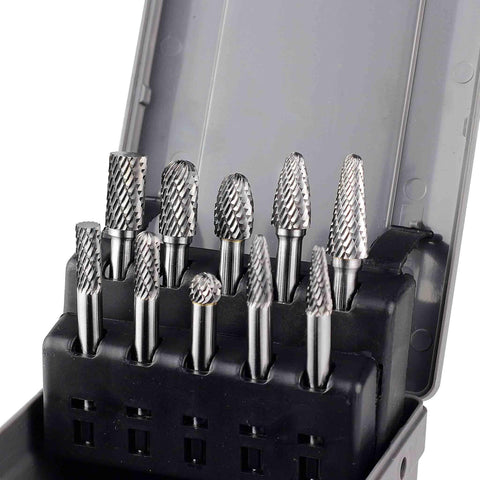Mastering Metalwork: Carbide Burr Bits for Hardened Steel
Hardened steel is one of the toughest materials used in modern manufacturing and industrial processes. Its superior strength and resistance to wear make it an ideal choice for high-stress applications such as machinery components, cutting tools, and automotive parts. However, its hardness also presents significant challenges when it comes to shaping, cutting, or finishing. This is where carbide burr bits come in as indispensable tools. Designed for working on hard metals like hardened steel, carbide burr bits are crafted from tungsten carbide, a material known for its extreme hardness and heat resistance. These burrs can cut through hardened steel with ease, making them the go-to solution for tasks that demand precision and durability.
Carbide burr bits offer versatility in tackling various aspects of metalworking on hardened steel, from rough material removal to detailed finishing work. One of the key advantages of using carbide burrs on hardened steel is their ability to maintain sharpness over extended use, even when working on such a tough material. Unlike traditional high-speed steel (HSS) burrs, carbide burrs are much more wear-resistant and can withstand the heat generated during high-speed cutting or grinding, making them ideal for prolonged and intensive metalworking tasks.
Cylindrical carbide burr bits are among the most commonly used for hardened steel, especially when working on flat or slightly curved surfaces. These burrs excel in tasks like surface grinding, deburring, and leveling welds on hardened steel components. The straight cylindrical design ensures an even removal of material, which is essential for maintaining precision in industrial applications. Whether you're preparing a steel part for further machining or removing excess material after welding, cylindrical carbide burr bits provide the accuracy needed for a clean, professional finish.
When working on hardened steel with complex shapes or detailed contours, ball-shaped carbide burr bits are the ideal choice. Their spherical design allows them to navigate smoothly over curved surfaces, making them perfect for tasks that require precision in confined or awkward spaces. Ball burrs are frequently used in industries where intricate metalwork is required, such as toolmaking, aerospace, and automotive repair. For instance, when working on the internal components of hardened steel molds or dies, ball burrs allow machinists to remove excess material without compromising the intricate detailing of the part.
For creating fine grooves, deep cuts, or beveled edges in hardened steel, cone-shaped carbide burr bits are an indispensable tool. The tapered design of these burrs enables them to reach into tight spaces and perform precision work with ease. Cone-shaped burrs are particularly useful for creating chamfers, engraving, or cutting sharp angles in hardened steel. Their pointed or rounded tips make them versatile for both rough cutting and finishing work. These burr bits are commonly used in die-casting, mold-making, and precision tool manufacturing, where the ability to shape and finish hardened steel with accuracy is critical.
Flame-shaped carbide burr bits are another essential type for working on hardened steel, especially in situations where both speed and precision are required. Their unique flame-like shape allows them to handle complex curves and irregular surfaces while maintaining control over material removal. Flame burrs are ideal for finishing welds or removing excess material from areas that are difficult to access with other burr shapes. In industries like metal fabrication and machinery repair, flame-shaped burrs are favored for their ability to deliver smooth, even cuts on hardened steel components, even in high-stress or high-heat environments.
Tree-shaped carbide burr bits are also highly effective for working on hardened steel, particularly in situations where internal cuts or detailed finishing is required. The pointed tree burr is perfect for cutting grooves or narrow channels, while the rounded tree burr excels at smoothing curved surfaces or removing material from intricate areas. These burrs are often used in tool and die making, where the ability to shape and finish hardened steel accurately is essential for creating high-quality tools and components.
In addition to the wide variety of shapes available, the cutting pattern of carbide burr bits plays a crucial role in their performance on hardened steel. Double-cut burrs, which feature a crisscross cutting pattern, are particularly well-suited for working on tough materials like hardened steel. The double-cut pattern allows for smoother cutting and reduced heat generation, which is vital when working with hardened metals that can be sensitive to thermal expansion or warping. Double-cut burrs also provide better control and produce finer finishes, making them ideal for tasks that require precision and a clean, polished look.
Using carbide burr bits on hardened steel offers significant advantages in terms of both performance and durability. Whether you're removing material from flat surfaces, shaping intricate designs, or finishing complex curves, the right type of carbide burr ensures that the work is done efficiently and with a high level of precision. Their ability to withstand extreme heat and maintain sharpness over time makes them a reliable tool for any metalworker dealing with hardened steel. With a range of shapes and cutting patterns available, carbide burr bits provide the versatility needed to tackle any project, from rough cutting to detailed finishing, making them an essential tool for mastering the challenges of hardened steel.
